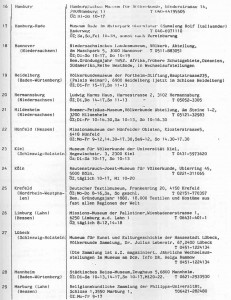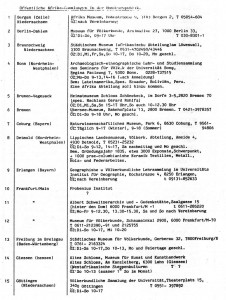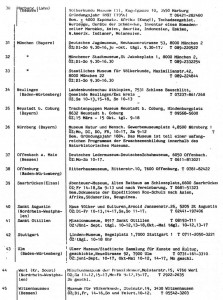Category Archives: musea Duitsland
Köln: Rautenstrauch-Joest Museum für Völkerkunde
Öffnungszeiten &
Adresse
Cäcilienstraße 29-33
50667 Köln
Telefon 0221 / 221 – 313 56
Telefax 0221 / 221 – 313 33
rjm@stadt-koeln.de
Di – So. 10 – 18 Uhr
Do. 10 – 20 Uhr
1. Do. im Monat: 10 -22 Uhr (außer an Feiertagen)
Mo. geschlossen.
Berlin: Ethnologisches Museum
The beginnings of the Museum of Ethnology date back to the Cabinet of Art and Rarities belonging to the Electors of Brandenburg. As early as the seventeenth century they collected not only works of European art but also rare objects from distant parts of the world. They eventually formed the Royal Prussian Art Cabinet from which, in 1829, the “Ethnographic Collection” was created. This collection then moved into the Neues Museum on Museum Island.
The Museum of Ethnology itself was founded in 1873. In 1886 it moved into its own building in Stresemannstrasse and acquisitions from throughout the world systematically increased the museum’s possessions.
The building in Stresemannstrasse was destroyed during World War II. As a result all surviving objects which had been removed for safekeeping were reunited after the war in the former storage building in Dahlem. By 1970 new extensions had been completed providing facilities not only for the Museum of Ethnology but also for the Museums of Far Eastern and Indian Art.
The Museum has a small Andamanese collection by one Mr. Jagor.
München: Staatliches Museum für Völkerkunde
The Staatliches Museum für Völkerkunde München was founded in 1868. The first collectors of artefacts and objects from outside Europe, which are today part of the museum’s collections, were members of the Wittelsbacher family, the royal dynasty of Bavaria. In 1830, for example, King Ludwig I bought a large collection of ethnographical objects from India and Oceania.
Today the museum is the second largest in Germany, outnumbered by Berlin only, with a collection of 150.000 objects and an exhibition area of 4.500 square meters.
The total area of the house (facilities, magazines, offices) is about 12.000 sqm, worked by a staff of 50-60 persons.
Seven curators are responsible for their (regional) departments and the objects are also under the surveillance of three restaurators. The museum has his own facilities for carpenting, metalworking, painting and restauration.
The museum has his own security staff for the building as well as for the exhibitions, and a permanent security office is working day-and-night-shifts 24 hours a day. Additionally during the nights an electronical security system is activated with direct connection to the police department. A modern fire-alarm-system is also part of the museums’ security systems.
A meeting- and conference-room (200 visitors max.) with a stage for music and dance is to be found in the first floor.
On the second floor you find the permanent exhibitions for Art and Culture of the Americas and of Africa and on the first floor you can see an exhibition about the Islamic World and – starting at the end of June – there’ll be a very fine exhibition about the Art of Oceania.
Every year the museum tries to illustrate a special subject in a non-permanent exhibition.




